New & Blue
Looking around, I was glad the interface hadn’t been pointlessly reimagined or rearranged. To all intents and purposes you’re presented with the same blue synth — slightly wider and with a few subtle layout tweaks — but otherwise as clear and accessible as ever. Zoom icons are used whenever a more detailed menu is available, a philosophy that keeps unnecessary clutter at bay. At this point I’d recommend that Omni virgins peruse the original review (and later 1.5 catch–up) and get up to speed with this powerful sample and synthesis hybrid.
I started by whiling away several hours playing a selection of new patches. The friendly database easily isolated the v2 entries and revealed a treasure trove of sounds comparable to those that turned me on to Omnisphere in the first place. Composers of cinematic soundtracks are going to love the many dark, evolving textures and subterranean booms, each ready to add instant class to any production. Lovers of vintage keyboards aren’t left out either; the collection includes various Mellotrons (strings, choir and flute, but sadly no brass), plus a playable Vox Continental. If classic string machines are more your bag, you’ll appreciate the addition of the ARP Solina and Roland VP330, along with an oddly noiseless Logan. All are enhanced by the presence of a modelled Solina Ensemble.
The list goes on and on, encompassing highly produced synths and sound effects by the bucket load. Aficionados of weird instrumentation and psychoacoustic sampling will probably rush to try the custom creations of Diego Stocco or the circuit–bent toy synths. Myself, I gravitated towards the selection of rolling, brushing hangdrums and then on to radioactive stalactites you can play without fear of your nose dropping off.
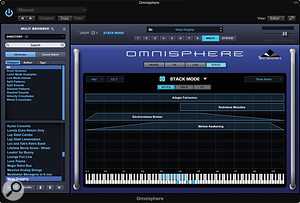 The powerful Stack mode facilitates the splitting and layering of up to eight sounds.While Omnisphere’s sound database includes a number of real instruments — pipe organ, glockenspiel, flamenco guitar, etc — reality always plays second fiddle to fantasy, often on an epic scale. This is best illustrated by the rich, expansive pads, arpeggios and rhythmic patches. Actually, there’s only one category I’ve ever found wanting: solo synths. Most of the solos are of the cutting, fast attack variety and my personal tastes are rooted in the flowing noodles of 1970s Germany. Sadly, it’s not so straightforward to duplicate my favourite Minimoog techniques, which is why I continue to hope for the appearance of envelopes modelled on those of classic monophonic synths.
The powerful Stack mode facilitates the splitting and layering of up to eight sounds.While Omnisphere’s sound database includes a number of real instruments — pipe organ, glockenspiel, flamenco guitar, etc — reality always plays second fiddle to fantasy, often on an epic scale. This is best illustrated by the rich, expansive pads, arpeggios and rhythmic patches. Actually, there’s only one category I’ve ever found wanting: solo synths. Most of the solos are of the cutting, fast attack variety and my personal tastes are rooted in the flowing noodles of 1970s Germany. Sadly, it’s not so straightforward to duplicate my favourite Minimoog techniques, which is why I continue to hope for the appearance of envelopes modelled on those of classic monophonic synths.
Finally, dance music has gained more prominence this time thanks to an infusion of EDM patches. This well–produced bag of churning basses, euphoric leads, risers and glistening arpeggios brings a welcome extra dimension to an already broad palette.
The Bigger Picture
The updates in Omnisphere 2.3 help to further refine what is, in my opinion, one of the most intuitive, easy to learn, efficient to work with and flexible user interfaces I’ve encountered. Omnisphere doesn’t do everything and isn’t meant to handle every need, but it is extremely flexible. Want to load a self-contained multi-timbral track? Grab a multi. Want to just try different presets and simple sounds? Use the patch browser – where you can also search for sounds using any number of criteria. Like a patch but want to change the sound? Go to the A or B layer of your patch and swap the oscillator to one of thousands of “sample” options or hundreds of “synth” ones. Like some aspect of the patch but not others? Use patch lock to keep the aspect you like while the others ones change each time you load a new patch. Like everything about the patch but want to hear it dry without the FX? Since the 2.2 update, you can just click the blue light beneath “FX” to enable or disable it. It’s all very fast and very easy.
Digging a little deeper into why things are so easy, it’s worth looking at how the system is setup. The tagging/metadata system is one of the best I’ve seen in a plug-in with great support for custom fields, making it great for organizing (and finding) sounds with the simple ability to add your own fields. There’s also the “Sound Match” feature that lets you display a variety of patches that share several characteristics with the current one. Of course, none of that would mean much without a library of sounds and Omnisphere 2 has a robust one. Each “sample” in the oscillator tab is actually anything from a single sample to a robustly mapped, velocity-switched and round-robin implemented multi-sample.
Omnisphere 2 does not offer the ability to create your own multi-samples and is not a replacement for software like Kontakt, but it is exponentially quicker and easier to swap an Omnisphere 2 “oscillator” multi-sample set than it is to dive into the file system of Kontakt and similar samplers and try to do something similar. In both cases, loading a patch is easy – but Omnisphere makes it a lot quicker to do mid-level editing, in part by eschewing the ability to go deeper. That said, Omnisphere 2 does support loading a single sample of user audio (with no file size limit specified) and dropping it into the oscillator level of a patch. Combined with Omnisphere 2’s granular synthesis (which is one of the most stable examples of granular synthesis I’ve used) this makes it easy to add custom textures using your own recorded sounds, just not build multi-samples out of them.
Modulation & FX
Put head to head, it’s easy to see why Omnisphere is so much more powerful than Serum.
In terms of Modulation, both synths have Envelopes and LFO’s, that can be bound to pretty much any control or setting within the synthesizer.
That being said, Omnisphere packs eight LFO’s per patch, as well as 12 ADSR envelopes.
Serum has 8 LFO’s and 3 Envelopes, which are more than enough for most sound design. But, when you want to create more complex sounds, more modulation is key.
The more oscillators you have, the more complex your patch is as well. And, while Serum has 2 Wavetable oscillators, a Sub-osc and a noise generator, you can have up to 20 different oscillators per patch with Omnisphere.
The amount of FX is also quite different between the two contenders, with Serum having 10 awesome creative effects, in contrast to Omnisphere’s 58 FX Units. You can even use modulators for your FX within Omnisphere, and they’re fully integrated within the synth.
Fractal Detail
As mentioned earlier, Omnisphere 2 makes it easy to work the way you want to, with the option to dive progressively deeper as you want to. The primary paradigm for this organization is the magnifying glass. When you are in a given tab and want to edit something more deeply, just look for the magnifying glass with the zoom in symbol to do just that. Want to go back to looking at more of a macro level? Look for the magnifying glass with the zoom out symbol. At any level of magnification, a context sensitive right-click menu is available with a host of options to modify what you’re working on. Although the sampled recordings used in the Spectrasonics library span decades from the 90s to present day, the interface is exceedingly modern, always appearing to opt for the fastest route the designers could find for the users to navigate around, rather than being concerned with emulating the look of vintage gear.
What Is So Good About Omnisphere?
Omnisphere has a lot of good things going for it. Easily the most versatile and powerful synth on the market, but what actually makes it so good?
Omnisphere is a sound design powerhouse. You can create a patch with 20 different sound sources, from wavetable generators, to sampled pianos, into a complex patch, and then load another patch, just as complex alongside it. You can play these two patches at the same time, or even mix them, to create one giga-patch.
The possibilities with Omnisphere are nearly infinite. If you have any other Spectrasonics’ products, such as Keyscape, you can even use Omnisphere as a hub for them.
This way you can have one plugin you go to, for all of your keyboards, synths, sampling, and any other sound design.
Besides computer processing power, there’s theoretically no other reason to use anything, but Omnisphere. Sure, you may want a specific patch, from a specific experimental 3rd party synth, but when it comes to classic synthesis, whether it’s wavetable, analog or granular, Omnisphere is the king.
Browser Yowser!
The sound browser has gained ‘progressive loading’. This term might once have caused ELP roadies to reach for their trusses, but here it refers to an optimised means of loading sounds. In practice you can usually start playing the moment your selection is made rather than having to wait for long samples to be read from disk.
Some browser categories have been reorganised and there’s a mini–browser available if needed. Of the other browser power–ups, Sound Match will summon a list of patches similar to the current selection. You might think Omnisphere already had more choices than a FIFA official at a lavish banquet, but this version gives you even more opportunities to agonise over slight variations. The indecisive should approach this tool with caution.
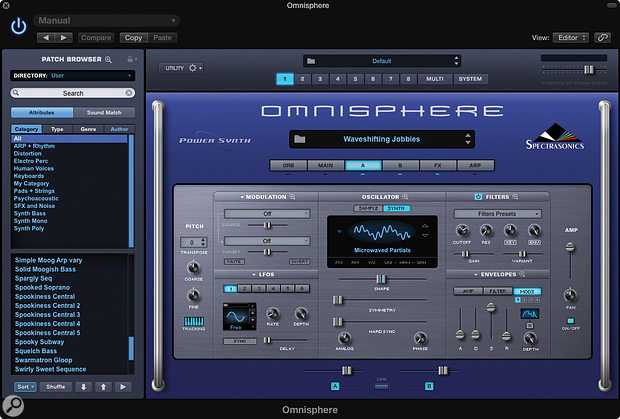 A synth layer primed with one of the many new wavetables.
A synth layer primed with one of the many new wavetables.
I felt more instantly drawn to ‘Sound Lock’. This feature introduces an extra level of control to the act of browsing whereby if you discover a favoured arpeggio pattern or effect combination, those sections can be carried forward into future search results. Not only is this a more nuanced form of browsing, it’s a rapid means of juggling existing material.
Patch–sharing is easier too, thanks to a simple two–stage process. First you assemble a project, batching together related sounds, multis and user sources. Next you take the ‘Share Sounds’ option and send the resulting file to your pals. Importing shared sounds is equally straightforward and I’m told there will soon be instructions on how to add original graphics and icons to user samples, thus giving them the same visual impact as the library content.
Omni Present
The upgrade is available exclusively as a download, although new users can purchase version 2 as a boxed edition. During the download (mine took a leisurely five hours) you’re advised to back up your STEAM folder; this contains everything needed should the unforeseen occur. You are also advised to back up the download itself once complete, in case reinstallation is ever necessary.
Once the Download Manager completes its data–grabbing, installation proceeds as a call and response system, after which Omnisphere 2 can finally boot. I was immediately directed to pick up an updated version (2.0.2c, and about a week later 2.0.2d) to reflect the small fixes made as OS2 spreads to a wider audience. As before, there is no stand–alone option. This may be of little relevance to studio–based composers, but for anyone planning to gig with Omnisphere, a stand–alone version remains desirable. In my wildest fantasies, I even dare to dream of an Omnisphere running on dedicated hardware.
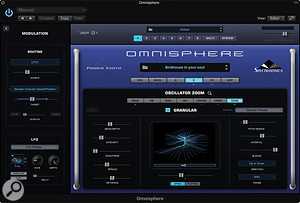 Understanding the refined granular engine is greatly assisted by the 3D visualisation.Knowing my Mac was close to the minimum system requirement (see below), I was concerned the update might prove too demanding or, worse, that old songs wouldn’t play correctly. After all, this is a complete replacement — you can’t simply open up the previous version when the going gets creaky. Fortunately, my fears have so far proved groundless and existing songs have loaded and played without issue, even those relying on multiple instances. I only experienced crackles with a few of the new factory patches, typically those that were heavily loaded with effects or other processor hitters. Suffice it to say that if you have a newish computer capable of running high–end plug–ins such as U–he’s Diva or Xfer Records’ Serum, you should have no fear of Omnisphere 2.
Understanding the refined granular engine is greatly assisted by the 3D visualisation.Knowing my Mac was close to the minimum system requirement (see below), I was concerned the update might prove too demanding or, worse, that old songs wouldn’t play correctly. After all, this is a complete replacement — you can’t simply open up the previous version when the going gets creaky. Fortunately, my fears have so far proved groundless and existing songs have loaded and played without issue, even those relying on multiple instances. I only experienced crackles with a few of the new factory patches, typically those that were heavily loaded with effects or other processor hitters. Suffice it to say that if you have a newish computer capable of running high–end plug–ins such as U–he’s Diva or Xfer Records’ Serum, you should have no fear of Omnisphere 2.
Raw Material
When you eventually drag yourself away from patch–surfing, there’s plenty to discover beneath the factory sounds. At the heart of each you’ll find material from the comprehensive sample collection or from the 400–plus DSP wavetables. Wavetables represent a major shot in the arm compared to the handful of traditional waveforms formerly provided. All the expected analogue shapes are featured, from generic single-cycle waveforms to waves inspired by specific instruments (for example, the ARP 2600, Arturia Minibrute, EDP Wasp and Moog Modular). Digital wavetable synths are also assimilated and whether you prefer the raw, grainy sound of a PPG or Prophet VS, or the smoother transitions of an Access Virus, Omnisphere 2 can cough up a decent approximation. It would be no slouch judged purely as a DSP synth.
 Exploring the sonic potential of light bulbs.However, the bulk of the STEAM folder is occupied by samples — distinctive, well–produced, occasionally wacky (or at least idiosyncratically recorded) samples. My own folder has gained approximately 20GB from the upgrade and now stands at a bulging 64GB.
Exploring the sonic potential of light bulbs.However, the bulk of the STEAM folder is occupied by samples — distinctive, well–produced, occasionally wacky (or at least idiosyncratically recorded) samples. My own folder has gained approximately 20GB from the upgrade and now stands at a bulging 64GB.
Joining the custom instruments, vintage keyboards and ‘modern’ sounds are a large number of musical phrases gathered from around the world. This is uncharted territory for Omnisphere, but I found it intriguing to audition the African chants and songs, sitar bursts, crazy Brazilian shouts and spooky erhus. We’re talking plunder on a scale unheard of since Victorian times, but I wasn’t immediately sure what it was all for. The phrases aren’t multisampled, nor do they seem designed for conventional play. To better appreciate them, we should move on and take a tour of synthesis Omnisphere–style.
Audio Import
Obeying the same simple–yet–powerful rule running through Omnisphere, audio import is so uncomplicated it could easily be missed. Yet it addresses what some felt was an important omission. Despite this ability, Spectrasonics are keen to point out that OS2 is still very much a synthesizer rather than a sampler, and shouldn’t be treated as such.
Introducing a user sample (or samples) is accomplished by dragging in the WAV or AIFF files, having first clicked the ‘User Audio’ button to reveal the option. The original sources are converted to Omnisphere’s internal format and copied automatically to the STEAM folder, ready for use in future work. Initially the samples are stored in a sub folder named according to the creation date. Should you wish to remove any or to rename the sub folders, you’ll need to perform those actions manually. Indeed, if you expect to make extensive use of original audio, now might be the ideal time to consider the location of your folder. For Mac users at least, this defaults to the system drive.
I imported a random spread of samples without issue, choosing a selection from short hits and synth bleeps to lengthy field recordings of streams and birdsong. On the surface, there doesn’t seem much you can do with this raw material compared to dedicated sample players. You have basic control over the sample’s start point and the direction of playback but after that the options start to peter out. If you want to truncate a sample, this is accomplished with envelopes; similarly, if you want a sample to loop, you have to fire it up in an external audio editor prior to import.
Loops don’t offer tempo-matching either, and if you activate ‘reverse’, looping is cancelled, a decision I’d have preferred to be optional. Ultimately, the requirement to perform some actions externally can be a bit of a spontaneity killer, and while I’m grateful for the manual’s list of suggested audio editors, I’d have been even more grateful for a loop on/off button, at the very least.
If unspecified, the sample is assumed to be pitched at C3, but this can be changed either in your editor or by including the desired note in the sample name. Thanks to the pervasive ‘modulate anything’ philosophy, you can freely assign the start of sample playback to be modulated, by sources that include LFOs, envelopes and random values for each note. When using a sample as a looping atmosphere or ambience, I found it helpful to avoid the adverse effects of transposition by deactivating keyboard tracking of pitch.
As you are confined to a single sample per layer, there’s no way to mimic the multisamples of the factory set. Had you hoped to compile an original mellotron brass instrument, for example, you’re out of luck. On the plus side, you can layer and split up to eight different sounds in Multi mode. Actually, Multi mode is a far more efficient means of playing several sounds at once — much better than running multiple instances of Omnisphere. It’s also fitted with the necessary tools to switch between sounds in a live situation and flip between layers without interrupting sustaining notes.
A further benefit of combining multiple sounds is the scope to layer up to eight arpeggios. In OS2, the arpeggiator now offers basic step-sequencer functionality in the form of note offsets per step. Several important parameters can be modulated too, although this failed to register as a good idea until I programmed a few practical examples. If you’re in the same boat, try connecting a slow LFO to the arpeggio’s step length or seizing performance control of playback speed via the mod wheel.
What It Is, What It Is Not – Some of the Competition
Omnisphere 2’s large library of sounds (responsible for the bulk of the 64 GB installation size) covers a lot of ground. Choirs, strings, unusual custom instruments and (above all else) a large library of thousands of sampled synthesizer sounds – among other things. The sounds consistently have a full and glossy sound to them, making them especially useful for filling the soundstage against other recordings with a “grainier”, “thinner” or smaller sound. This aspect of the aesthetic is just one of the reasons why it complements, rather than replaces, so many of the other libraries I use. The name of the game is variety: with a few notable exceptions, you won’t find a lot of “deep sampling” (with lots of dynamic layers, round-robins and articulation switching) but you will find a wide variety of well recorded sounds.
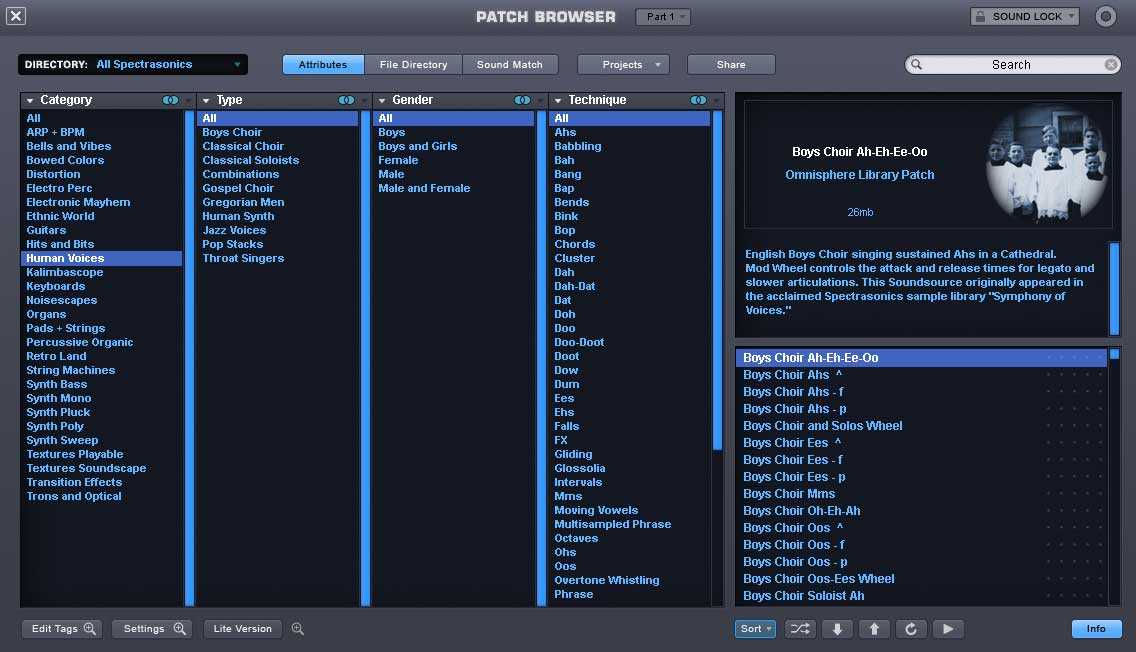
For instance, since Omnisphere 2 features the overwhelming majority of Spectrasonics back catalog, you’ll find most of the sounds from their 90s “Symphony of Voices” and “Vocal Planet” series, giving Omnisphere the widest variety of choral sounds that I’ve ever seen in a single product anywhere. The choirs do not have word building, legato sampling or in many cases even multiple dynamic layers (unlike modern offerings from Virharmonic, Strezov Sampling, Soundiron, 8Dio and many others) but many of these sounds simply have not been recorded with similar ensembles elsewhere. As such, I frequently layer Omnisphere choral sounds alongside dedicated choir libraries, especially the Omnisphere Japanese Children’s Choir. There’s a similar story for guitars, mandolins and electric sitar – with the sounds coming from Spectrasonics 90s library series “Hans Zimmers Guitars”. Omnisphere is not meant to compete with ethnic instrument collections like Quantum Leap Ra or Best Service Ethno World, though there are few such patches on offer, especially in regards to plucked strings (including some from the aforementioned guitar library).
Regarding the original recordings and programming, the quality control and programming is quite consistent – you don’t really need to worry about running into bum notes or having patches break, which is fairly rare in this industry. Many of the older samples, like some of the choirs, have fairly short loop points (which is part of the reason why layering them is especially useful), but this is not an issue with the newer content.
Omnisphere is not intended as a dedicated orchestral plug-in. It has samples from two great large ensemble string sustain sessions that can be great for sketching, layering or using as pads. Look elsewhere if you need individual string sections, multiple orchestral articulations or other instruments from the orchestra. You won’t find the library caters to orchestral brass or woodwinds at all, and the percussion on offer isn’t really aimed at orchestral use either. You’ll need a dedicated library for these types of sounds instead.
If you want rhythmic sounds and textures, Omnisphere 2 has them in spades – and makes it unusually quick and easy to addition the same rhythm with multiple sounds. No other virtual instrument I’ve used makes it quicker to construct a synth rhythm section. Similarly, there is a huge collection of pads and atmospheres – and the modulation system gives you a lot of power to make them evolve over time. There are many less expensive competing synth virtual instruments, but none of them offers the volume of content that Omnisphere 2 does.
Like the competing Cakewalk’s Rapture before it, Omnisphere 2 also offers a large variety of DSP waveforms for native synthesis (the Spectrasonics manual says Omnisphere 2 added over 400 new ones) with extensive modulation support, but Omnisphere 2 makes it much faster and easier to find and load the sounds you like and organize your library. The flip side is that each Omnisphere 2 patch can have fewer oscillators loaded at once – but the flip side is that you can stack up to 8 patches in a given Omnisphere instance.
Omnisphere 2’s most frequently compared competitor is reFX Nexus 2 (which our own Alex Arsov reviewed in 2013), but there are big differences between the two. For starters, the starter Nexus 2 package ($249 USD MSRP) has 2,250 presets and uses 13GB of samples, compared to over 12,000 presets in circa 64 GB for Omnisphere 2. The full Nexus 2 package (which contains 98 expansion) has a $3,919 USD MSRP and contains over 12,500 presets and over 100 GB of samples. Clearly we are dealing with two very different beasts here – but you can learn a lot more about it by reading Arsov’s review.
The Patch Library Update 2.3 Update
Like previous updates, Omnisphere 2.3.0 is split up into multiple parts: the 2.3.0h software update and the 2.3.0c patch library update. The patch library update covers three parts: new impulses responses (which are generally used to change the timbre or reverb of a sound) for compatibility with Spectrasonics new product Keyscape (which can be used in Omnisphere or on its own), tagging improvements and velocity curve presets. I can’t speak to the improved tagging (as the nature of the improvements wasn’t specified) but the velocity curve presets are much easier to check. To access the velocity curve presets you go the “Main” tab in the patch menu, then press the magnifying glass next to the “V-Curve” button – then click the downward arrow to the right of the word “Velocity Curve Zoom.” This gives you a list of a variety of popular MIDI keyboards – so if a model close to yours is available, you can load a preset designed to be used with that keyboard and the patch should sound close to the designer’s intent. The list of keyboards covered is as follows.
- Akai: MPK49, MPK88
- Kawai: M8000
- Korg: Kronos
- M-Audio: Keystation 88, Keystudio, Keystudio2
- Novation: Launchkey, SL MkII
- Roland: A-50, A-80, A88
- Yamaha: Montage
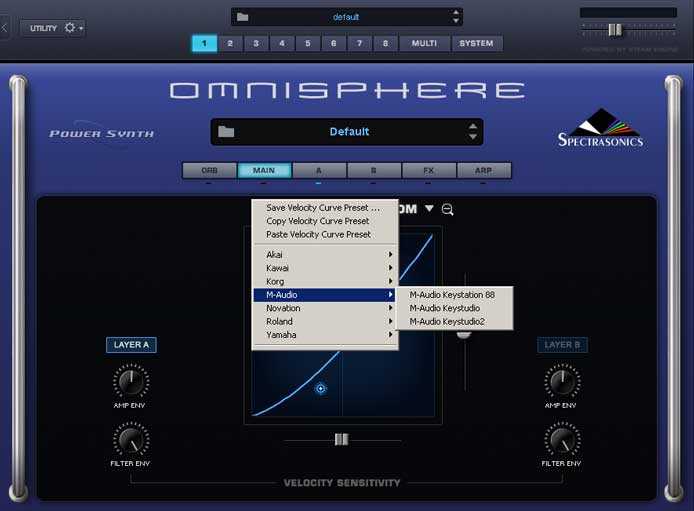
Since I used a Yamaha keyboard for this review, I loaded the Montage curve and compared it to a default linear curve (as well as the other presets). The curve seemed well tailored to the heavier touch of many of the Yamaha keyboards (as compared to many other manufacturers), switching from the default curve on many patches (a slight downward swing) to a slight upward swing that made it easier to hit the higher velocity ranges. It’s not a groundbreaking new feature, but it’s a simple and effective way for people to get the most of their keyboard controller without having to spend time doing editing and trial and error. If you modify the curve you can either copy and paste it to another part, or you can save it and load it at any point in the future using the pre-existing Omnisphere functionality. Here, as in many other areas, I appreciated how Omnisphere offers many different ways to do similar things and caters to them equally well. Omnisphere rarely forces you to think of things in a different way, it tries to make it easy to do it the way you naturally would – and do it quickly.

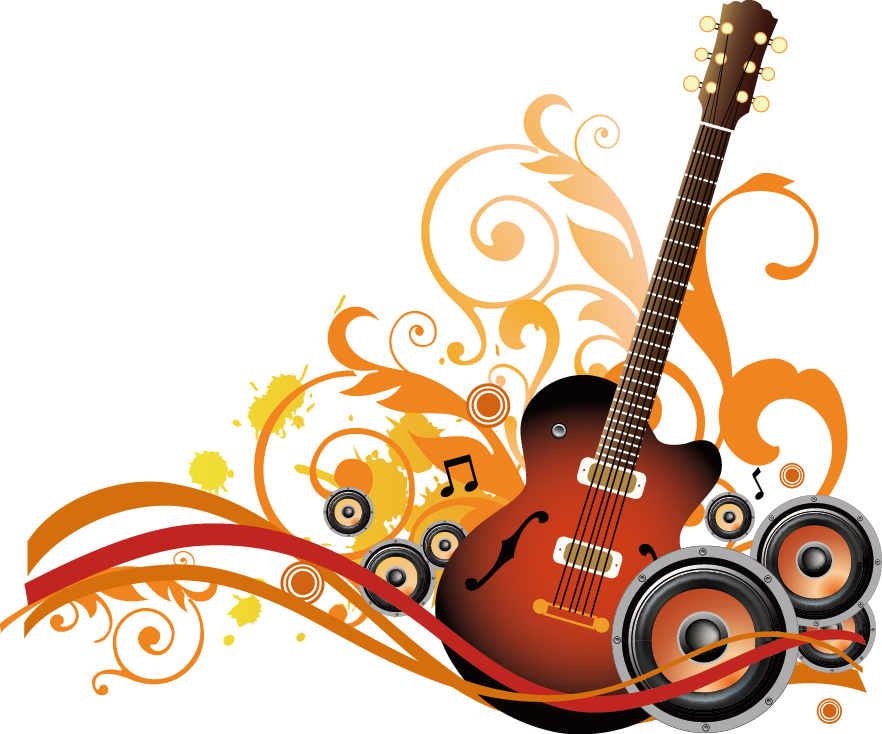








![Omnisphere 2.0.3d [56 gb] скачать торрент fl studio 12](http://gitara-vrn.ru/wp-content/uploads/1/b/6/1b677259889ecc73b69c2712af8f4935.jpeg)






















